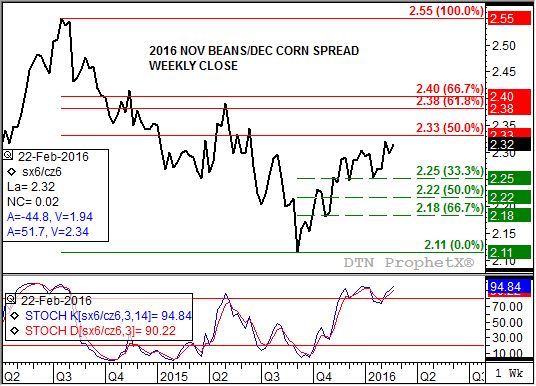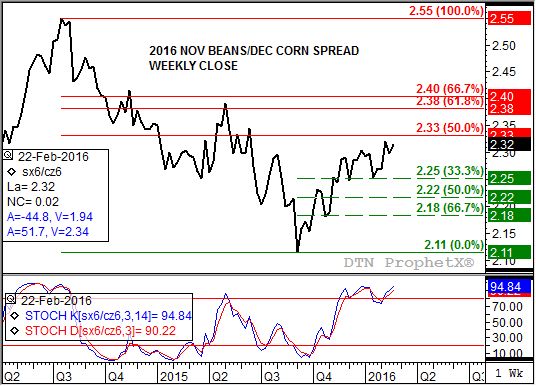Technically Speaking
Beans vs. Corn: Who Bought Who?
From the time combines finish churning their way across the U.S. in the fall the discussion becomes what crop, generally between corn and soybeans, will buy acres away from the other over the winter. With spring set to begin (unofficially) this coming Tuesday, March 1, winter will be behind us and the idea of spring planting causing growers to salivate.
Last week at its annual Ag Outlook Forum, USDA released its first look at 2016 planted area. The results were somewhat surprising, at least measured by what has been heard over the course of the winter. USDA forecast corn at 90 million acres, up from 2015's 88 ma, and soybeans at 82.5 ma versus last year's 82.7 ma. Back in December, just prior to the DTN/The Progressive Farmer Ag Summit, talk was that soybean plantings could increase by 2.5 ma to 85.3 ma, with corn fairly close to the Outlook guess at 90.1 ma. The question quickly becomes: Did the futures spread between the respective new-crop contracts behave in such a way that corn bought acres away from soybeans.
The answer is no. Or maybe yes, depending on your point of view.
Back in early September 2015, the weekly close chart for the November 2016 soybeans/December 2016 corn futures (SX6/CZ6) spread established an uptrend. The week of September 8 saw the spread close at 2.11, with weekly stochastics (momentum study) well below the oversold level of 20%. By the week of October 5 the spread had climbed to a close of 2.19 as its stochastics posted a bullish crossover (faster moving blue line crossing above the slower moving red line, with both below the oversold level of 20%). This indicated that the trend had turned up, meaning that SX6 should start to pull away from CZ6. That would mean more soybeans, right? Stay with me.
P[L1] D[0x0] M[300x250] OOP[F] ADUNIT[] T[]
As fall turned to winter the spread continued to gain strength, closing at 2.29 heading into Summit (week of November 30) before dipping back to 2.25. The spread has stabilized between 2.25 and its target level of 2.33, closing at 2.32 two out of the last three weeks while weekly stochastics hold well above the overbought level of 80%. In other words, the uptrend looks like it is nearing its end.
Let's pause for a minute to better understand all the numbers mentioned above. The 2.33 target marks the 50% retracement level of the previous downtrend from 2.55 through the 2.11 low. Using the uptrend from 2.11 through the 2.32 highs (weeks of February 8 and February 22), retracement support is now pegged at 2.25 (33%), 2.22 (50%), and 2.18 (67%). These figures are interesting when taking into account what the spread did during its uptrend.
Recently, the spread posted low weekly closes of 2.25 (January 19 and December 7). Before that low weekly close was 2.18 (week of October 26). One way of using retracement analysis is to project what targets might be based on what fits as support and resistance levels are built during a trend.
Let me explain: After the initial rally from 2.11 through 2.23 (Wave 1) thee spread pulled back to 2.18 (Wave 2). From there it rallied again to 2.30 (Wave 3), establishing support at 2.25 (Wave 4). Projecting a full 50% retracement of the previous downtrend (to 2.33) resulted in support pegged at 2.26, 2.22, and 2.19. By adjusting the upside target slightly to 2.32, retracement levels came in exactly where the spread showed support before at 2.25, 2.29, and 2.18.
Could the spread extend to 2.33? Sure, but weekly stochastics above 90% indicate the uptrend is nearing its end. In other words, corn should start gaining on soybeans.
Why would this happen if corn bought acres away from soybeans while losing ground in price? That's a great question. It's possible wet, late winter weather could start to cause concern for slow planting progress this spring over parts of the U.S. Midwest. It's also possible that more soybean acres are going to be planted than forecast at this time. We'll see how the news/weather plays out over the coming months.
One last note: During my winter travels I have yet to hear from producers that they are actually increasing corn acres. On the other hand, they also aren't planning on increasing soybean acres either. Yet one large seed dealer I visited with spoke of an almost 10% year-to-year increase in corn sales while soybeans are lagging what was seen in early 2015.
Stay tuned as this story continues to develop.
To track my thoughts on the markets throughout the day, follow me on Twitter:www.twitter.com\Darin Newsom






Comments
To comment, please Log In or Join our Community .